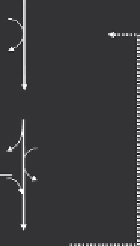Biology Reference
In-Depth Information
Phosphoenolpyruvate
2ADP
Pyruvate
kinase
2ATP
Pyruvic acid
CO
2
CoA
SH
2NAD
+
2NADH
+
H
+
Acetyl-CoA
Figure 2
Feedback loop in the linkage between glycolysis and the citric acid cycle.
In the final reaction of glycolysis, phosphoenolpyruvate produces pyruvic acid. Pyruvic acid then
produces acetyl-CoA, some amount of which is needed to continuously replenish the citric acid
cycle (not shown). If more acetyl-CoA is produced than can be used in the citric acid cycle, it
accumulates and feeds back (dotted arrow) to inhibit pyruvate kinase, the enzyme responsible for
the first step in the reaction. This in turn will stop glucose from entering the glycolytic pathway.
The crucial idea required to flesh out Bernard's and Cannon's insights into
how biological systems are organized to maintain themselves in the face of
external challenges is that of negative feedback. As I noted above, the notion of
negative feedback was repeatedly rediscovered in different engineering contexts
in which it was important to regulate or control a process so as to insure a regular
output over 2000 years. With the development of the cybernetics movement and
control theory in engineering in the twentieth century, it came to be viewed as a
general design principle. Although enriched by a variety of tools, such as the use
of off-line emulators and filtering techniques (Grush, 2004), negative feedback
remains at the center of the modern field of control theory. It also plays a critical
role in the understanding of biological systems. Feedback loops provide a way of
insuring that critical processes, such as the consumption of nutrients to generate
ATP, only occur when they are required. Figure 2 illustrates an instance of
negative feedback at the junction between glycolysis and the Krebs cycle which
halts the generation of pyruvate from phosphoenolpyruvate (coupled with the
synthesis of ATP) when there is already a plentiful supply of acetyl-CoA waiting
to enter the citric acid cycle.
5. CYCLIC ORGANIZATION AND GÁNTI'S CHEMOTON
As important as negative feedback is in providing control mechanisms in living
organisms that enable them to maintain homeostasis, it is not sufficient to explain

